- This topic has 1개 답변, 2명 참여, and was last updated 4 years, 1 month 전에 by
 야곰.
야곰.
1 답변 글타래를 보이고 있습니다
-
글쓴이글
-
-
련호 김참가자
- 글작성 : 1
- 답글작성 : 0
그래프의 vertice를 탐색하는 방법에 여러가지가 있지만, 아래와 같은 문제를 해결하기 위해서 BFS 알고리즘이 사용됨.
- 최소 스패닝 트리 생성
- vertice 간의 경로 찾기
- 두 vertice 간의 최단 경로 찾기
간단한 예제
BFS는 하나의 노드을 기준으로 시작함.
그리고 그 노드을 기준으로 근접한 노드들을 모두를 먼저 방문(visit)함.
근접한 노드를 먼저 방문하기 위해서 큐를 이용함.- 그래프 초기 상태
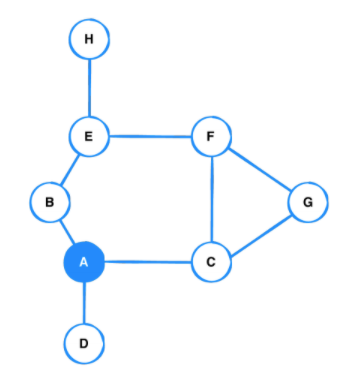
- 첫 번째로 방문할 노드A 선택 및 큐 삽입
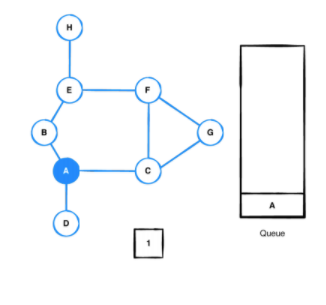
- 큐의 가장 상단에 있는 노드(노드A)에 방문하고 노드A에 근접한 노드들을 모두 큐에 삽입 (큐에 삽입할때 이미 방문했거나, 이미 큐에 있는 노드를 다시 삽입하지 않도록 처리 필요함)
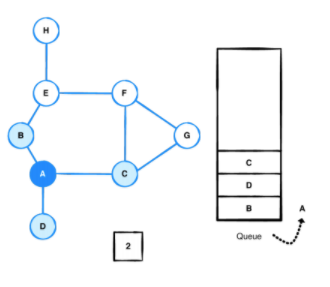
- 큐의 가장 상단 노드B를 방문 → B의 근접 노드를 큐에 삽입
- 그리고 계속 반복(큐의 최상단 노드를 꺼내서 방문하고, 그 노드의 인접노드를 큐에 삽입)
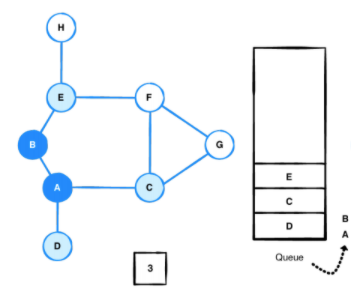
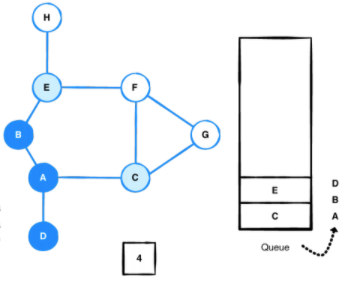
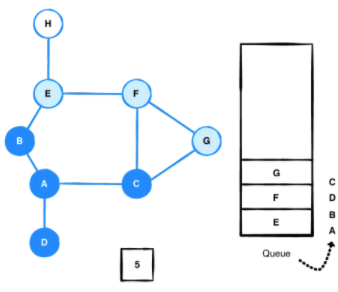
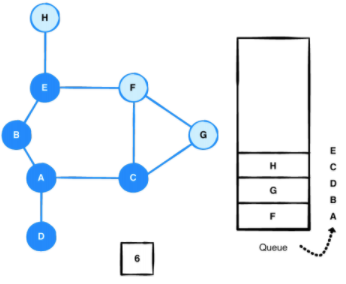
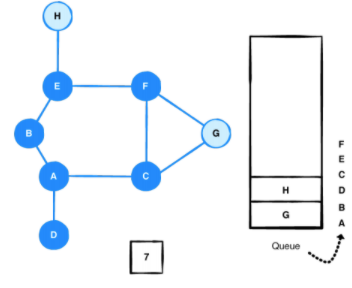
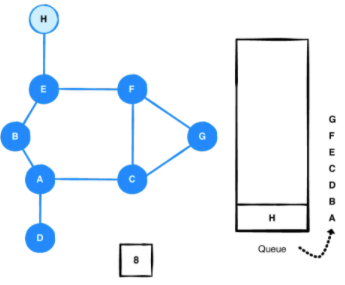
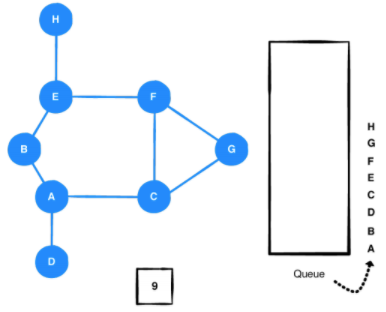
시작노드를 기준으로 너비우선탐색 순서를 연결하면 (논리적으로) 트리를 얻을 수 있습니다. 각 레벨은 너비 탐색의 레벨을 의미합니다.
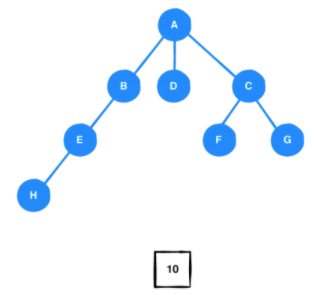
구현 코드
import UIKit // ############################################################################# // 기존 그래프 구현부 public struct Vertex<T> { public let index: Int public let data: T } extension Vertex: Hashable where T: Hashable {} extension Vertex: Equatable where T: Equatable {} extension Vertex: CustomStringConvertible { public var description: String { "\(index): \(data)" } } public struct Edge<T> { public let source: Vertex<T> public let destination: Vertex<T> public let weight: Double? } public enum EdgeType { case directed case undirected } public protocol Graph { associatedtype Element func createVertex(data: Element) -> Vertex<Element> func addDirectedEdge(from source: Vertex<Element>, to destination: Vertex<Element>, weight: Double?) func addUndirectedEdge(between source: Vertex<Element>, and destination: Vertex<Element>, weight: Double?) func add(_ edge: EdgeType, from source: Vertex<Element>, to destination: Vertex<Element>, weight: Double?) func edges(from source: Vertex<Element>) -> [Edge<Element>] func weight(from source: Vertex<Element>, to destination: Vertex<Element>) -> Double? } extension Graph { public func addUndirectedEdge(between source: Vertex<Element>, and destination: Vertex<Element>, weight: Double?) { addDirectedEdge(from: source, to: destination, weight: weight) addDirectedEdge(from: destination, to: source, weight: weight) } public func add(_ edge: EdgeType, from source: Vertex<Element>, to destination: Vertex<Element>, weight: Double?) { switch edge { case .directed: addDirectedEdge(from: source, to: destination, weight: weight) case .undirected: addUndirectedEdge(between: source, and: destination, weight: weight) } } } public class AdjacencyList<T: Hashable>: Graph { private var adjacencies: [Vertex<T>: [Edge<T>]] = [:] public init() {} public func createVertex(data: T) -> Vertex<T> { let vertex = Vertex(index: adjacencies.count, data: data) adjacencies[vertex] = [] return vertex } public func addDirectedEdge(from source: Vertex<T>, to destination: Vertex<T>, weight: Double?) { let edge = Edge(source: source, destination: destination, weight: weight) adjacencies[source]?.append(edge) } public func edges(from source: Vertex<T>) -> [Edge<T>] { adjacencies[source] ?? [] } public func weight(from source: Vertex<T>, to destination: Vertex<T>) -> Double? { edges(from: source) .first { $0.destination == destination }? .weight } } extension AdjacencyList: CustomStringConvertible { public var description: String { var result = "" for (vertex, edges) in adjacencies { // 1 var edgeString = "" for (index, edge) in edges.enumerated() { // 2 if index != edges.count - 1 { edgeString.append("\(edge.destination), ") } else { edgeString.append("\(edge.destination)") } } result.append("\(vertex) ---> [ \(edgeString) ]\n") // 3 } return result } } // ############################################################################# // 너비 우선 검색 - BFS extension Graph where Element: Hashable { func breadthFirstSearch(from source: Vertex<Element>) -> [Vertex<Element>] { var queue: [Vertex<Element>?] = []// 큐 // var queue = QueueStack<Vertex<Element>>() // 큐 var enqueued: Set<Vertex<Element>> = [] // 중복 방문을 체크하기 위한 Set var visited: [Vertex<Element>] = [] // 방문한 노드 배열(방문 순서대로) queue.append(source) // 큐에 초기 노드 삽입 // queue.enqueue(source) // 큐에 초기 노드 삽입 enqueued.insert(source) while !queue.isEmpty, let vertex = queue.removeFirst() { // 큐에서 하나 꺼냄 // while let vertex = queue.dequeue() { // 큐에서 하나 꺼냄 visited.append(vertex) // 방문 let neighborEdges = edges(from: vertex) // 인접한 노드 확인 neighborEdges.forEach { edge in if !enqueued.contains(edge.destination) { // 이미 방문했거나, 큐에 들어가 있는지 체크 queue.append(edge.destination) // 처음 발견된 노드라면 큐에 삽입 // queue.enqueue(edge.destination) // 처음 발견된 노드라면 큐에 삽입 enqueued.insert(edge.destination) } } } return visited } } let graph = AdjacencyList<String>() let A = graph.createVertex(data: "A") let B = graph.createVertex(data: "B") let C = graph.createVertex(data: "C") let D = graph.createVertex(data: "D") let E = graph.createVertex(data: "E") let F = graph.createVertex(data: "F") let G = graph.createVertex(data: "G") let H = graph.createVertex(data: "H") graph.add(.undirected, from: A, to: B, weight: 0) graph.add(.undirected, from: A, to: C, weight: 0) graph.add(.undirected, from: A, to: D, weight: 0) graph.add(.undirected, from: B, to: E, weight: 0) graph.add(.undirected, from: C, to: F, weight: 0) graph.add(.undirected, from: C, to: G, weight: 0) graph.add(.undirected, from: E, to: H, weight: 0) graph.add(.undirected, from: E, to: F, weight: 0) graph.add(.undirected, from: F, to: G, weight: 0) print(graph) let vertices = graph.breadthFirstSearch(from: A) vertices.forEach { vertex in print(vertex) } // ############################################################################# // Chapter 39 BFS Challenge2 - iterative 코드를 recursive 코드로 작성 extension Graph where Element: Hashable { func bfs2(from source: Vertex<Element>) -> [Vertex<Element>] { var queue: [Vertex<Element>?] = [] var enqueued: Set<Vertex<Element>> = [] var visited: [Vertex<Element>] = [] queue.append(source) enqueued.insert(source) bfs(queue: &queue, enqueued: &enqueued, visited: &visited) return visited } private func bfs(queue: inout [Vertex<Element>?], enqueued: inout Set<Vertex<Element>>, visited: inout [Vertex<Element>]) { guard !queue.isEmpty, let vertex = queue.removeFirst() else { return } visited.append(vertex) let neighborEdges = edges(from: vertex) neighborEdges.forEach { edge in if !enqueued.contains(edge.destination) { queue.append(edge.destination) enqueued.insert(edge.destination) } } bfs(queue: &queue, enqueued: &enqueued, visited: &visited) } } let vertices = graph.bfs2(from: A) vertices.forEach { vertex in print(vertex) } // ############################################################################# // Chapter 39 BFS Challenge3 - 단절된 부분이 있는지 확인하는 함수작성 extension AdjacencyList { func isDisconnected() -> Bool { guard let (firstVertex, _) = adjacencies.first else { // 1 return false } let visited = breadthFirstSearch(from: firstVertex) // 2 for (vertex, _) in adjacencies { // 3 if !visited.contains(vertex) { return true } } return false } } print("isDisconnected: \(graph.isDisconnected())")퍼포먼스
그래프를 순회하면서 각 노드는 한번씩만 큐에 추가됨 → O(V) 그래프를 순회하면서 모든 edge를 한번씩 거쳐가야함 → O(E)O(V + E) 공간 복잡도는, 노드들을 모두 저장해야하기 때문에 O(3V) → O(V)
키 포인트
너비 우선 검색 (BFS)은 그래프를 탐색하거나 검색하기 위한 알고리즘입니다. BFS는 다음 정점을 통과하기 전에 현재 정점의 모든 이웃을 탐색합니다. 그래프 구조에 인접 정점이 많이 있거나 가능한 모든 결과를 찾아야 할 때 이 알고리즘을 사용하는 것이 좋습니다. 큐 데이터 구조는 레벨을 더 깊이 다이빙하기 전에 정점의 주변 모서리를 통과하는 우선 순위를 지정하는 데 사용됩니다.2020-03-29 오후 12:09 #4947
-
-
글쓴이글
1 답변 글타래를 보이고 있습니다
- 답변은 로그인 후 가능합니다.
